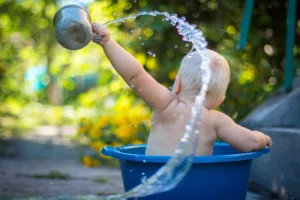Baby, Meet Cup – Cup, Meet Baby!
The six-month well visit is one of my favorite visits. Six-month-olds are usually happy and smiley, stay mostly in one place while I’m doing the exam, and haven’t yet equated my presence with “pointy kisses” that soon follow. They’re also curious to learn more about the world around them – and a big part of exploring this world is by trying to put all of it directly into their mouths. There is usually a lot of discussion at the six-month visit about feeding. What is the best way to start solid foods – do we puree everything or do baby-led weaning? Is it time for peanuts? Can baby eat meat now? In all the talk about solids, liquids get short shrift, and it’s easy to forget that it’s time to introduce the baby to a cup.
Like with all new skills, learning to drink from a cup takes some time and practice. It’s usually recommended to wean off the bottle around 12-18 months. Prolonged bottle use can lead to dental decay, accelerated weight gain and getting less nutrition from solid foods. Working backward from that rule of thumb it makes sense to start early to get her well accustomed to drinking from a cup before weaning. Babies can drink from a cup once they’re able to sit unsupported – usually around the same time they’re starting solid foods. By starting early, he will have these skills down pat once it’s time to start reducing bottle feeding.

Can I Give My Baby Water?
Once a baby is 6 months old, it’s okay to introduce water – and a cup is a great way to do so! It’s also the easiest to clean up. You can also use formula or breast milk. Offer your baby a cup with meals, and this will get her used to having a beverage with meals in her high chair. Avoid juice and other sugary beverages – these don’t have any significant nutritional value, and only add to tooth decay.
But Which Cup Should I Introduce First?
Open cup? Straw cup? 360 cup? Sippy cup? There is no shortage of conflicting recommendations online, especially around the latter two options. I don’t think the situation is quite as dire as the internet would have us believe. The good news is that most kids, and most adults, manage to successfully learn to drink from a variety of vessels in a variety of contexts. There is no good evidence that cup choice makes a big difference long term (If your child has a facial or developmental difference, talk to your pediatrician or feeding therapist about the best choice for your child).
Much like learning how to eat solid food, learning the developmental skill of drinking from an open cup takes time and practice, and is messy. It’s usually well suited to a more contained environment. On the other hand, a convenient spill proof option that your baby can use for water when you’re on the go on a hot summer day is a great tool. It’s also fascinating to watch your baby learn how to use each of these different cups and see how proud of herself she is when she figures out these new skills!
